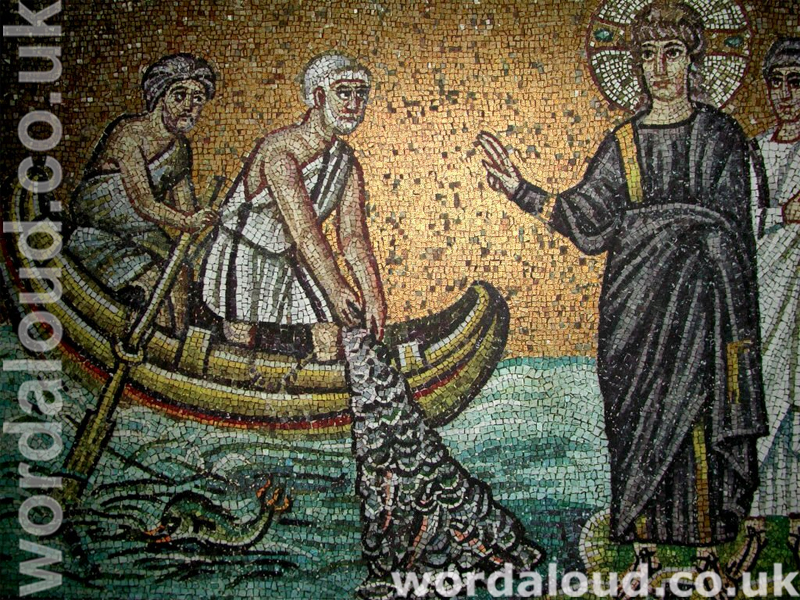Christian Art | Easter To Pentecost | Miracles Of Jesus | Jesus Walks On Water
John 6: 16-21 Audio Bible KJV | King James Audio Bible | Daily Verses
16 And when even was now come, his disciples went down unto the sea,
17 And entered into a ship, and went over the sea toward Capernaum. And it was now dark, and Jesus was not come to them.
18 And the sea arose by reason of a great wind that blew.
19 So when they had rowed about five and twenty or thirty furlongs, they see Jesus walking on the sea, and drawing nigh unto the ship: and they were afraid.
20 But he saith unto them, It is I; be not afraid.
21 Then they willingly received him into the ship: and immediately the ship was at the land whither they went.
John’s account of the miracle of Jesus walking on the water differs in some significant ways from the accounts given in the Gospels of Matthew and Mark. The context is the same, the miracle of the loaves and fishes has taken place, and the disciples are crossing the Sea of Galilee, while Jesus has remained on shore, going into the hills to pray alone. We understand, as well, in each of the Gospel accounts, the symbolic meaning of the disciples being alone and troubled on the waters, to which situation the Lord comes to help them.
Darkness has fallen and the disciples have rowed some distance. The wind has risen and the disciples must have been concerned for their safety. Mark tells us specifically that the disciples are distressed. They are far from the safety of the shore and their situation is truly difficult.
Christian tradition has long seen the boat as symbolizing the Church, established by Christ and then bound to contend with troubles, persecutions, temptations, which test the faithful. Through faith, we are enabled by Christ to remain firm to his purpose. It is, though, very easy to falter in faith when troubled waters rise up against us.
The faith of the disciples is not yet perfect. They have a long journey of faith ahead of them, which will carry them through Easter and then beyond. It is understandable. The disciples do not yet see Jesus’ miracles as a sign of his divinity. The reality of Jesus transcends all they could have known or expected. The Good News is in every sense new!
Jesus is loving and patient with his disciples. There will be further signs and miracles to strengthen, to enable, their faith and their knowledge of the reality of Jesus, and further teachings to enable the disciples to carry the message of salvation to all men. In these Bible verses, this is symbolized by Jesus coming to them, walking on the water. Where there is trouble, Christ can simply walk over it. Such is our faith. And when we may be, as the disciples are, frightened by the seemingly impossible approach of our Lord, he will reassure us and help us to accept his presence, and the miracles he is ready to perform in our lives. We may consider this as we confess our sins.
In John’s Gospel, it is when the disciples recognize Jesus that they immediately experience great relief and welcome him into their boat. The Lord is with them. And, immediately, their boat has reached the other shore.
Compare with these verses of John’s Gospel, Matthew’s account of the miracle of Jesus walking on the water (Matthew 14: 22-33) and also Mark’s (Mark 6: 45-52).
‘The Lord allowed his disciples to enter danger to make them suffer, and he did not immediately come to their aid; he left them in peril for the whole night, to teach them to be patient and not to be accustomed to receiving immediate succour in tribulation.’ Theophylact

![]()
Audio Bible KJV | King James Audio Bible | King James Version | Endnotes
Can We Believe That Jesus Walked On Water?
It is good for a Christian to believe that Jesus walked on water because it affirms Christian faith in the divine nature of Jesus and Jesus’ complete and transformative power over the natural world – including our own minds. The story of Jesus walking on water is a miraculous event to strengthen the faith of believers and to inspire Christians to trust in Jesus’ power to guide and protect us.
This is faith. Our Christian faith is figured in narrative. The Christian narrative is ordered to expand and to transcend our understanding toward God and immeasurably in excess of this world.
The story of Jesus walking on water is a source of comfort and hope for believers in times of uncertainty and fear. As the disciples struggled to navigate the stormy waters, Jesus came to them and reassured them, saying: ‘It is I; be not afraid.’ (John 6:20)
Our belief in the story of Jesus walking on water can deepen a Christian’s understanding of the power and significance of faith. As the disciples initially struggled to trust in Jesus’ power and control over the stormy sea, the story demonstrates the transformative power of faith as in the story the disciples eventually come to believe and to find peace.
Christian leaders and authorities have said:
- Saint Augustine of Hippo, an early Christian theologian, wrote about the significance of Jesus’ miraculous walk on water, saying: ‘The Lord walking upon the sea of this world, treads down its waves, that they may no longer toss and trouble us.’
- Saint Thomas Aquinas, a medieval Christian theologian, wrote about the symbolism of the story, saying: ‘By walking on the sea Christ shows that he is above all earthly things, and that he rules over the waves of our passions and over the storms of the world.’
- Martin Luther wrote about the story in his commentary on the Gospel of John, saying: ‘This walking on the sea was a sign and seal that Christ is Lord over everything that opposes him, be it the sea or the devil.’
- John Calvin wrote in his commentary on the Gospel of John: ‘As Christ treads upon the sea, and holds it up by the power of his word, so he subdues every obstacle that stands in the way of his people.’
- John Wesley, the founder of Methodism, wrote in a sermon about the story: ‘This miracle declares that Christ is the Lord of nature, and the master of every circumstance that can possibly arise.’
- Pope Saint Leo the Great in the 5th Century wrote in a sermon on the feast of the Nativity: ‘In Christ, the whole fullness of the divine nature dwells bodily, and by his power he walks upon the sea and commands the winds.’
- Saint John Chrysostom, an early Church father, preached about the story, saying: ‘By walking on the sea, Christ shows us that he is the Lord of all things, and that he has the power to command even the elements of nature.’
- Saint Tertullian, an early Church father, wrote about the story in his treatise On The Resurrection Of The Flesh, saying: ‘Christ’s walking on the sea proves his divinity, for he who is Lord over the sea and the winds must be God.’
- Saint Ambrose, 4th Century bishop and theologian, wrote about the story in his treatise On The Holy Spirit, saying: ‘By walking on the sea, Christ demonstrates his power over the world and over the elements of nature, and reveals his divine nature to his followers.’
- Saint Gregory of Nyssa, 4th Century bishop and theologian, wrote about the story in his treatise On the Making of Man, saying: ‘By walking on the sea, Christ shows us that he is the Lord of all creation, and that he has the power to overcome every obstacle that we may face.’
- Saint Origen, 3rd Century Church father, wrote about the story in his commentary on the Gospel of John, saying: ‘By walking on the sea, Christ reveals his divine power and his authority over the natural world, and teaches us to trust in his care and protection.’
- Pope Francis spoke about the story in a homily in 2013, saying: ‘Christ’s walk on the water teaches us to trust in his power and love, even in the midst of life’s storms and uncertainties.’








